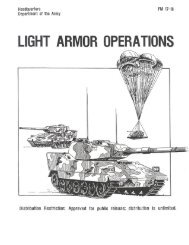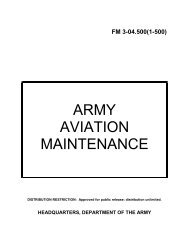fm 44-100 us army air and missile defense operations
fm 44-100 us army air and missile defense operations
fm 44-100 us army air and missile defense operations
You also want an ePaper? Increase the reach of your titles
YUMPU automatically turns print PDFs into web optimized ePapers that Google loves.
FM <strong>44</strong>-<strong>100</strong><br />
C-8<br />
C-31. TERS will transition into the Tactical Event System (TES) in the near<br />
future. TES will <strong>us</strong>e the same communications architecture currently <strong>us</strong>ed by<br />
TERS, but will provide more timely <strong>and</strong> more reliable <strong>missile</strong> launch<br />
warning. TES warning messages will originate at different ground segments<br />
which each contribute different but complementary detection <strong>and</strong> processing<br />
capabilities. The components of TES are the Attack <strong>and</strong> Launch Early<br />
Reporting to Theater (ALERT) system, the Tactical Detection <strong>and</strong> Reporting<br />
(TACDAR) system, <strong>and</strong> the Joint Tactical Ground Station (JTAGS).<br />
C-32. JTAGS is a satellite receiver that allows direct downlinks of <strong>missile</strong><br />
<strong>and</strong> other warning data into the theater. Data is processed <strong>and</strong> disseminated<br />
in theater via the TRAP <strong>and</strong> TIBS networks. JTAGS will also disseminate<br />
voice warning to forces in the theater. Within 2 minutes of <strong>missile</strong> launch,<br />
tactical parameters, to include estimated impact area, are available to<br />
support tactical <strong>missile</strong> <strong>defense</strong> <strong>operations</strong>. USSPACECOM executes its<br />
control of JTAGS through the Army Space Comm<strong>and</strong> (ARSPACE).<br />
HISTORICAL PERSPECTIVE<br />
C-33. The Army has been actively involved in space <strong>operations</strong> since Dr.<br />
Wernher von Braun <strong>and</strong> other German scientists joined the Army's program<br />
to develop militarily <strong>us</strong>eful <strong>missile</strong>s <strong>and</strong> rockets in 1945. The efforts of Army<br />
scientists working at White S<strong>and</strong>s Missile Range in New Mexico <strong>and</strong> at<br />
Redstone Arsenal <strong>and</strong> the Marshall Space Flight Center in Alabama resulted<br />
in the birth of the United States space program. In 1958, the Army space<br />
program became the nucle<strong>us</strong> of the newly created National Aeronautics <strong>and</strong><br />
Space Administration (NASA), which assumed responsibility for all civilian<br />
space <strong>operations</strong>. That same year, NASA launched the nation's first satellite<br />
into orbit <strong>us</strong>ing an Army Redstone rocket. The Redstone was also <strong>us</strong>ed to<br />
launch a Mercury capsule carrying Comm<strong>and</strong>er Alan B. Shepard into space<br />
in 1961, marking the beginning of the nation's manned space flight program.<br />
C-34. As NASA <strong>and</strong> the newly created United States Air Force assumed<br />
greater responsibility for civilian <strong>and</strong> military space <strong>operations</strong>, the Army's<br />
role in space declined proportionately. The Army's space interests were<br />
limited to development of <strong>air</strong> <strong>and</strong> strategic ballistic <strong>missile</strong> <strong>defense</strong><br />
capabilities, <strong>and</strong> to exploitation of national space capabilities for support of<br />
tactical <strong>operations</strong>.<br />
C-35. In 1973, the Army Space Program Office (ASPO) was established to<br />
improve support by national capabilities to tactical comm<strong>and</strong>ers. The Joint<br />
Tactical Exploitation of National Capabilities Program has fielded a number<br />
of systems for <strong>us</strong>e by Army comm<strong>and</strong>ers. The Strategic Defense Comm<strong>and</strong><br />
(SDC) has led Army efforts to develop <strong>defense</strong>s against both strategic <strong>and</strong><br />
tactical ballistic <strong>missile</strong>s.<br />
C-36. In 1985, DOD established the United States Space Comm<strong>and</strong><br />
(USSPACECOM) to exercise combatant comm<strong>and</strong> over the service's space<br />
<strong>operations</strong>. The Comm<strong>and</strong>er in Chief, USSPACECOM, provides space<br />
support to other theater comm<strong>and</strong>ers as a supporting CINC. The Army's<br />
Space <strong>and</strong> Strategic Defense Comm<strong>and</strong> (SSDC) consists of ARSPACE <strong>and</strong><br />
SDC <strong>and</strong> is the Army component of USSPACECOM. ARSPACE is the Army











